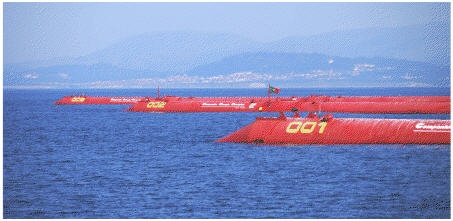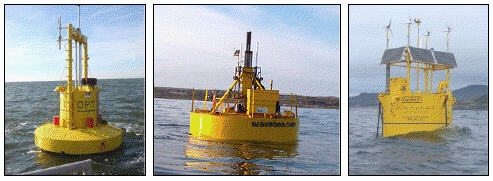

António F. de O. Falcão, IDMEC, Instituto Superior Técnico, Technical University of Lisbon.
Offshore wave energy converters are in general more complex compared with first generation systems. This, together with additional problems associated with mooring, access for maintenance and the need of long underwater electrical cables, has hindered their development, and only in the last few years some systems have reached, or come close to, the full-scale demonstration stage.
There is a substantial variety of typically offshore wave-energy devices, some of which reached, or are close to, the prototype stage. In most cases, there is a mechanism that extracts energy from the relative oscillating motion between two bodies.
This is the case of the Pelamis, developed in UK, a snake-like slack-moored articulated structure composed of four cylindrical sections linked by hinged joints, and aligned with the wave direction. The wave-induced motion of these joints is resisted by hydraulic rams, which pump high-pressure oil through hydraulic motors driving electrical generators. Sea trials of a full-sized prototype (120m long, 3.5m diameter, 750 kW rated power) took place in 2004. A set of three Pelamis devices was deployed off the Portuguese northern coast in September 2008, making it the first grid-connected wave farm worldwide (Figure 1).

Figure 1. The three-unit 3×750 kW Pelamis wave farm in calm sea off northern Portugal, 2008.
Several concepts use the heaving motion of a slack-moored axisymmetric buoy reacting against the inertia of another body (Figure 2). In the case of the Powerbuoy (developed in USA) the second body is a submerged disc, whereas the Wavebob (an Irish concept) consists of two co-axial axisymmetric floating bodies oscillating differently. In both cases, the PTO consists of a high-pressure-oil hydraulic circuit, with rams and a hydraulic motor. The Aquabuoy is a device that combines two concepts developed in Sweden: the IPS buoy and the hose pump, which were tested in the sea at about half-scale in 1982. The Aquabuoy consists of a buoy, whose heave oscillations, by reaction against the inertia of the water inside an acceleration tube (located beneath the buoy), produce high-pressure water flow by means of a pair of hose pumps.
This is converted into electrical energy by a conventional Pelton turbine driving an electrical generator. A prototype was built and tested in 2007 off the coast of Oregon, USA.

Figure 2. Heaving point-absorber prototypes: Powerbuoy, Wavebob and Aquabuoy.
In some cases, the device consists of a set of heaving buoys reacting against a common frame and sharing a common PTO. This is the case of FO3 (mostly a Norwegian project) in which the frame is a large floating structure with very low resonance frequency, of the Danish Wave Star (the frame stands of the bottom) and the Brazilian hyperbaric device whose frame is a breakwater. These are recent devices equipped with pressurized hydraulic systems, the first one having been tested at 1/3 scale and the last two at 1/10 scale.
The Archimedes Wave Swing (AWS), basically developed in Holland, is a fully submerged device consisting of an oscillating upper part (the floater) and a bottom fixed lower part (the basement). The floater is pushed down under a wave crest and moves up under a wave trough.
This motion is resisted by a linear electrical motor, with the interior air pressure acting as a spring. A prototype, rated 2 MW (maximum instantaneous power) was deployed and tested in 2004 off northern Portugal. The AWS was the first converter to use a linear electrical generator, a technology that is being developed by other teams (University of Edinburgh, UK, Uppsala University, Sweden, and Oregon State University, USA) for wave energy applications. Except for the Pelamis, the oscillating-body devices mentioned above absorb energy essentially from the heaving mode of oscillation. Other modes, namely pitching and surge, can also be used. This is the case of the French system named Searev, a large floating device enclosing a heavy horizontal-axis wheel behaving like a mechanical pendulum.
The rotational motion of the pendulum relative to the hull activates a hydraulic PTO. The Oyster (UK) and the Waveroller (Finland) are devices based on the inverted pendulum, designed to be located near-shore in water depths of 10-12m. The concept consist of a flap-shaped buoyant body hinged at the sea bottom, whose pitching motion, activated by the waves, drives a hydraulic ram that pumps high-pressure fluid (sea water in the case of Oyster, oil in Waveroller). A 10-15 kW prototype of Waveroller was tested in the sea in Portugal in 2007. A full-sized prototype of Oyster (300-600 kW) was recently built in Scotland.